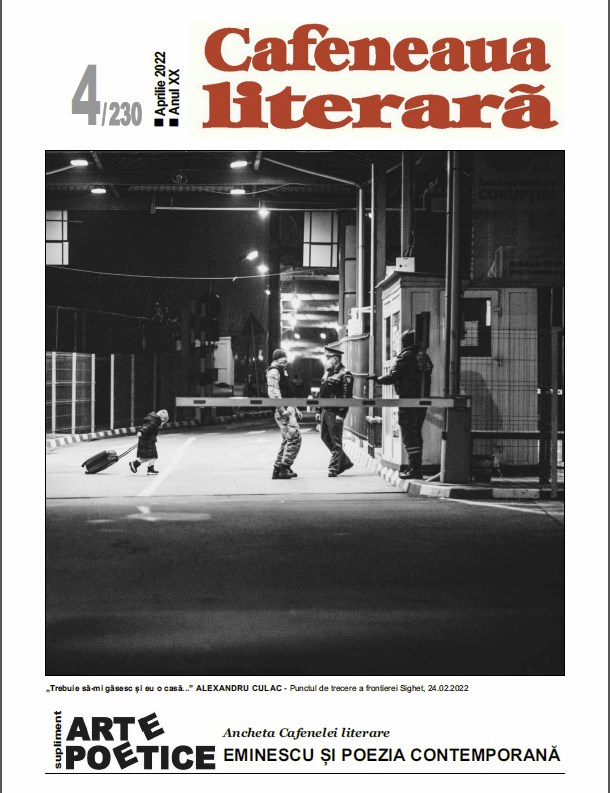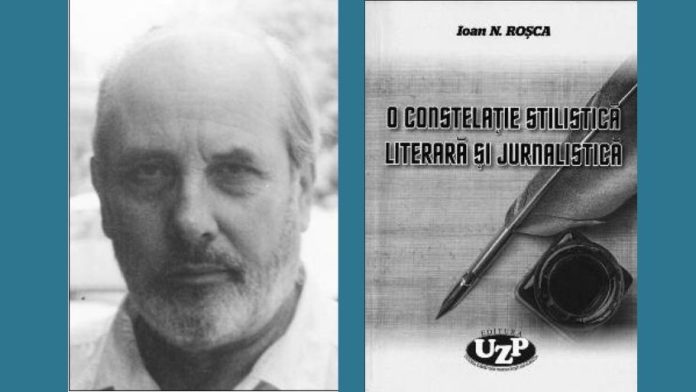Article published in Revista Cafeneaua Literară
University professor Dr. Ioan N. Roșca , a prestigious poet and journalist, recently published an exciting book: A literary and journalistic stylistic constellation , UZP Publishing House, Bucharest, 2021. Chronicles, essays, studies are collected here, which the author printed, in time, between 2011 and 2021, in various magazines in the country and abroad.
The author has chosen important and difficult topics, which he analyzes with high competence, as a challenge to meditation, on the role and purpose of literature, of journalism, as a “historian of the moment”. The comments are profound and show that the philosophy teacher is also a very good literary critic and historian, dubbed by an excellent journalist. He made a rigorous selection of the authors and books he commented on, choosing, not coincidentally, the title of the book: A literary and journalistic stylistic constellation , as it aims, as stated in “Foreword”, to analyze, “under the dome of the concept of style,” the differences between aesthetic values, expressed in literary-artistic language, and other types of values and of expressive embodiments, including the differences between artistic and journalistic language ”.
The author’s finding is also interesting, according to which “all authors cultivate or have cultivated, like Eminescu, not only literature, but also journalism.” He emphasizes the kinship between the two areas of creative activity.
The author also followed the problems of method, composition and style specific to each writer and tried to capture the “distinct voice of each”.
The first study is dedicated to the concept of cultural style, as defined by the French naturalist and biologist Buffon (1707-1788), complex personality, mathematician, cosmologist, philosopher, writer, member of the French Academy (since 1753), author of the famous Discourse on style : “Writing well means thinking well, feeling well and expressing well; it means having spirit, soul and taste at the same time. Style presupposes the reunion and exercise of all the intellectual faculties: the ideas alone form the background of the style, the harmony of the words is only its accessory which depends only on the sensitivity of the organs ”. “Style is the man himself.” (From the volume: Ioan N. Roșca, Condillac, D’Alembert, Buffon about sciences, arts, philosophy, in translated and commented texts , Romania of Tomorrow Foundation Publishing House, Bucharest, 2015).
According to Buffon, style presupposes order and movement put into thoughts, the force of genius, and the general features of style are: nobility, gravity, candor, reason, harmony of words, elevated, high, sublime tone. Buffon’s contribution to the definition of cultural style is fundamental. It will later be developed by other great thinkers, such as Friedrich Nietzsche, Oswald Spengler, Lucian Blaga.
From this perspective, the author analyzes “Literary and artistic beauty in relation to other spiritual values.” He emphasizes the difference between artistic language, which appeals to artistic images (epithets, comparisons, metaphors, personifications, hyperbole, etc.), and journalistic, informative language, devoid of literary ornaments. On the other hand, there are more elaborate journalistic genres (reportage, pamphlet, essay, interview, survey), which acquire special artistic values (see our great writers, who were also great journalists). There are, of course, similarities between the two types of language, literary and artistic. Both relate to the same realities and use the same words, but with different meanings. The literary-artistic work is fiction, invention, while the journalistic work is permanently related to reality, even if, sometimes, it also uses literary means (reportage, for example).
A parenthesis: Professor Roșca suggests the idea that the phrases sometimes used in literary criticism, namely those of philosophical poetry and religious poetry , do not seem happy to him, and that “more appropriate” would be the formula of reflective poetry. This is where I break up with him. All the great literary critics, G. Călinescu, Tudor Vianu – the book Philosophy and poetry , Alexandru Tănase – the book Lucian Blaga, philosopher-poet, poet-philosopher, E. Lovinescu and others. they talked about philosophical poetry, seen as a distinct category of poetry, compared to religious poetry, erotic poetry, nature poetry (landscape), social poetry (patriotic), etc. Eminescu’s poems, Luceafărul , Letter I , Gloss , The prayer of a Dacian , Ode (in ancient meter) , for example, poems of deep philosophical meditation about life and death, about the purpose and meaning of the world, are not just poems of “reflection”, which would narrow their value. Of course, philosophical poetry is reflective poetry, but we cannot integrate erotic poetry , for example, into the category of reflective poetry, although it may contain elements of “reflection.”
In another study, “The topicality of Maiorescian conception of art for art”, Professor Roșca brings back the idea of art autonomy in relation to other forms of culture, applying the theoretical considerations of Titu Maiorescu to the analysis of Romanian poetry and prose, dramaturgy, for highlight the great values and differentiate them from pseudo-values. There is a lot of ink in Romanian literature on this topic. The Gherea-Maiorescu controversy regarding the idea of art for art and art with a tendency is well known. We do not now resume the pros and cons of the famous controversy. Maiorescu’s conception of art as art, as autonomy in relation to other forms of culture (science, morality, politics), is current and imposes itself as a value judgment in the appreciation of the work of art, to discourage imposture and non-values.
Another important study, “Clarity and depth in Eminescu’s poetry”, demonstrates the exemplary qualities of a literary critic of Ioan N. Roșca. The author emphasizes the great accessibility of Eminescu’s poetry, its simplicity , but, beyond these (a first level of reception), there are other layers of depth and understanding, accessible to an informed reader.
A sustained communication at the “Eminescu, the Journalist” Evenings analyzes “The Christian substratum of Eminescu’s poetry in the interpretation of Theodor Damian”. The poet, theologian and philosopher Theodor Damian, in his book The Idea of God in Eminescu’s poetry , refutes the idea of the atheism of Eminescu’s poetry and accredits the influence of the Orthodox religion on it. The fragment invoked to support Eminescu’s atheism is the well-known verse from the poem “Emperor and Proletarian”: “Religion – an invented phrase by them”, without taking into account that it is the discourse of the revolutionary proletarian, torn from context. On the other hand, many other poems invoke God (“The Prayer of a Dacian,” “The Morning Star,” etc.) or are composed in the form of a litany (“Prayer”), or contain words from the realm of religion.
As for the poet’s thesis of a radical pessimism, Theodor Damian brings into question Eminescu’s journalism, in which he vehemently criticizes the political class, liberalism. Eminescu defended the culture specific to the Romanian people, he valued the role of the Orthodox Church, so his pessimism is relative.
An excellent essay is about Nicolae Labiș, seen by the literary critic Ioan N. Roșca with a fresh, undeformed eye. The author carefully analyzes Nicolae Labiș’s poetry, emphasizing the longing for harmony and purity from the first volume antum, Primele iubiri (1956), where he praises the harmony of nature, plant and animal life (“The Beginning”, “First Loves”). At the same time, the poet recorded the disharmony of nature, as well as that of society. The masterpiece “The Death of the Deer” is an excellent example of disharmony in the natural plane, and the poems about war (“Zurgălăul”, “Rhapsody of the Forest”, “On the Shells of Stânișoara”), of social disharmony. The literary critic analyzes without prejudice the poems dedicated to the Party, the Communist, emphasizing the same idea of harmony, through the poet’s sincere belief in the communist ideal, which promised peace, the perfection of man, the restoration of lost unity. This explains the presence of poems such as: “Marx’s”, “Manifesto”, “Sketches for proletarian humanism”, etc. The poet later discovered the major dissonances between theory and practice and blamed them with great pamphlet force (the poem “The Common Man”). “Spirit of the depths”, the poet retreats into his inner world (“I live in a world other than yours”) and seeks peace, inner harmony, yet living the uneasiness and tension of the real plane. Nicolae Labiș remains “the mace of a generation” (Eugen Simion), who announces the next generation of poets: Nichita Stănescu, Marin Sorescu, Ioan Alexandru, Adrian Păunescu and others.
In this chronicle, I did not intend to analyze each essay of the author, but to emphasize his high qualities as a theorist, literary critic and cultural journalist, “historian of the moment”, which records with objectivity and empathy the cultural and literary phenomenon. of contemporaneity, addressing us an invitation to read, an intellectual challenge.
I mention, in passing, the other studies and essays on the poetry of Ion Horea, of Dumitru Ichim, which is in the “poetic search for salvation”, the poetic creation of Theodor Damian, at the confluence with the other spiritual values, of Dan Anghelescu, “Suspicious in the postmodern world in a postmodernist style”, of Passionateia Stoicescu, of Mihaela Albu, “a polyvalent personality”, in the “sphere of intertextual poetry”, of Octavian Mihalcea, between “twilight lights and a new sunrise”, his Marius Daniel Mihu, “a seeker of light”, by Sorin Ivan, “whitmanian poet of the Renaissance in pandemic times”, the book Literary Bible of Virgil Diaconu, which represents “The Critical Direction in Biblical Research”, the short prose of Florentin Popescu, a “Storyteller between reality and fantasy”, the Romanian creation of Dan Ghițescu, Iulian Chivu, George Vlaicu, Mihail Diaconescu, Vintilă Horia’s interwar journalism, Theodor Damian’s New York cultural diary, Mircea M. Ionescu’s diaries.
Here is a long list of poetry, prose, journalism, journals, which demonstrates the wide range of comprehension and deep interpretation, to the point, of authors and works of different values, which summarizes the exceptional ability of Ioan N. Roșca to be a objective and sensitive witness to the literary and cultural phenomenon of the present, enriching our minds and souls through comments of high intellectual standing.
Literary Café – Ion HAINEȘ, pages 26-27



